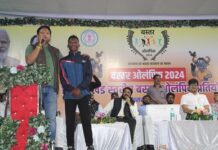Ajay Bhardwaj
The recent visit of Congress Vice-President Rahul Gandhi to the Somnath Temple apparently for political and electoral reasons, has once again raked up memories of how his great-grandfather Jawahar Lal Nehru as the first Prime Minister of the country had expressed his displeasure and disapproval to the rebuilding of the Somnath temple. Had the will of Nehru prevailed, the Somnath temple would still have been a ravaged relic of our culture and spiritual heritage. Jawahar Lal Nehru had told KM Munshi catagorically in 1951, “I don’t like your trying to restore Somnath. It is Hindu Revivalism.”
By many accounts after the Nawab of Junagarh had fled to Pakistan in October 1947, the Indian army immediately moved in within a month to take control. Sardar Patel, the then Deputy Prime Minister and union Home Minister, who was monitoring the integration of princely states, rushed to Junagarh where he was accorded a massive public reception. In response, Patel promised to rebuild the Somnath temple which had been ravaged brutally by the Islamic invaders.
Patel reportedly moved the resolution in the Union Cabinet, which granted its consent in spite of Nehru’s serious reservations. After the Cabinet cleared it, Mahatma Gandhi threw a spanner saying that the government should not fund the rebuilding of the temple and instead let the people contribute. Determined Patel constituted a trust for the purpose and appointed KM Munshi, the then Union Agriculture, as its chairman.
Nehru Miffed
That Nehru did not like Munshi’s involvement in the project was made explicitly clear by Nehru when he wrote to him saying he did not like it as it augured Hindu revivalism.
An undeterred Munshi made sure that the glory of the ancient temple was duly restored, so after the task was completed, he invited President Rajendra Prasad for its inauguration.
This again rankled Nehru quite a bit as he went on to formally write to the President giving his mind on the matter. “I confess I do not like the idea of your associating yourself with a spectacular opening of the Somnath temple. This is not merely visiting a temple…but rather participating in a significant function which unfortunately has a number of implications”.
But the President decided to inaugurate the temple, anyway. And in his address, he categorically underlined how Somnath symbolised Bharat’s ancient glory. He said, “It is my view that the reconstruction of the Somnath Temple will be complete on that day when not only a magnificent edifice will arise on this foundation, but the mansion of India’s prosperity will be really that prosperity of which the ancient temple of Somnath was a symbol.”
Completely rattled with the President’s assertion, Nehru went a step further to demonstrate his discomfort as he wrote to all the chief ministers saying “It should be clearly understood that this function is not governmental and the Government of India has nothing to do with it…we must not do anything that comes in the way of our state being secular.”
Nehru made it clear that his secularism meant not doing anything to glorify our ancient heritage and culture, though he kept doling out a large number of concessions to the Muslims.
It was about the time when the so-called Liberals started gaining a foothold in the government and Bharat’s cultural and spiritual heritage was left in the back seat.
The rebuilding of Somnath, in a way, demonstrated not any
resurgence of Hinduism as Nehru tried to put it, but an effort to retrieve the ancient glory of the land that was marauded by the invaders.
In the ancient times Somnath Temple, one of the 12 Jyotirlinga shrines of Lord Shiva, had come to epitomise not just the abundance of wealth that Bharat had, but also the big feats that art of metallurgy had achieved in those times.
Levitating Shivalinga
The levitating Shivalinga at the Somnath Temple remains an acme of scientific achievements of the times. Scientists have been wondering till date how could this be feasible. It remains a marvel how ancient Hindu craftsmen could devise a system through which they could keep the Shiva-linga afloat in the air without support, a mechanism that was called magnetic levitation.
Some scientists have attributed this to “clever use of bismuth as diamagnets. Diamagnets, they say, can be levitated in stable equilibrium in a magnetic field, with no power consumption. Was it the play of magnetic properties of the iron-nickel meteorite Shivalinga and the diamagnetic properties of bismuth?
While Mahmud of Ghazni was the first invader to ravage the shrine and plunder the wealth stacked inside the temple in 1024, the temple has been a constant attraction for invaders due to gold, diamonds and other precious possessions.
Even Alauddin Khilji, whose character is in news currently due to the ongoing controversy over Sanjay Leela Bhansali’s film Padmavati, also led one of the 17 attacks on the temple in 1299.
Wassaf, a 14th-century Persian historian, describes the destruction of Somnath temple at the hands of Khilji saying “The idol was adorned with a jewel-studded gold crown and a pearl necklace, and was of admirable workmanship. After looting the jewels, the Muslim soldiers decided to destroy the idol. The Hindus offered them a thousand pieces of gold to spare the idol, but the soldiers rejected the demand.”
In 1395 the temple was once again destroyed by Zafar Khan, who was governor of Gujarat under the Delhi Sultanate.
In 1451 Mahmud Begada, sultan of Gujarat ravaged the temple yet again. As if in every century it had to happen, in 1546 the Portuguese in their destruction spree, razed the Somnath Temple to the ground. In 1665 the Temple was destroyed once again by Mughal Emperor Aurangzeb.
Golden Temple Links
While the valuables looted from the temple from time to time reached far and wide in the world, its two gates were in news in Punjab in 2010. It was believed that the two gates installed at the entry of the sanctum sanctorum of the Golden Temple since 1800 were those of the Somnath temple.
Maharaja Ranjit Singh is believed to have brought them from Afghanistan after one of his invasions. The gates have since been removed by the SGPC.















